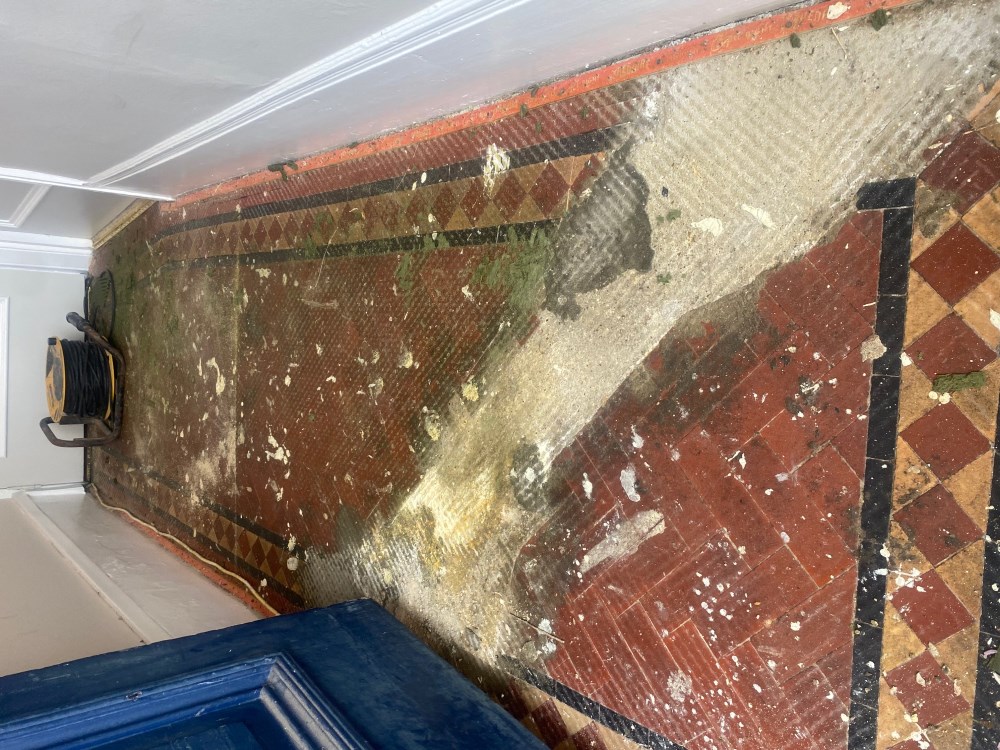I was asked to view a Victorian tiled communal hallway floor at a property in Hither Green that serviced two Victorian maisonettes. The original Victorian tiles had been covered in carpet and an underlay for many years and now that had worn through the residents decided to investigate having the original tiles restored.
I went over to the property to inspect the floor and create a plan for its restoration. We pulled the carpet back and discovered that a section of tiles were missing and the gap had been backfilled with a sand cement mix. I didn’t know at this point whether the base was solid or if the tiles around the repair would also need to be lifted and replaced.
The Victorian tiles had also been imprinted with the pattern from the carpet underlay and the carpet had been secured to the floor with gripper and adhesive all of which would need to be removed as part of the restoration.

Undaunted with the task at hand I created a quote for this restoration which included replacing the missing tiles with matching replacements then deep cleaning and sealing the tiles to protect them going forward.
Happy with the quote I was given the go-ahead to start the work and pre-order the replacement tiles.
Repairing a Carpet Covered Victorian Tiled Hallway
When I started the work, I found that the base was generally in good condition and solid so not many additional tiles would need to be replaced. I then set about replacing the main body of the tiling and the border where it was needed, using new reproduction geometric tiles. They were as close a match to the original however being newer they were a slightly different shade.
Once all the tiles had been replaced and repaired, I turned my attention to cleaning the floor to remove the staining and years of dirt. I started this with an application of Tile Doctor Remove & Go which is designed to remove sealers and other contaminants. The tiles did not have a visible sealer on them however it did have years of grease and oil that would need to be broken down.
A strong dilution of Remove and go was applied to the tiles and then allowed to dwell and soak in for around half an hour. It was then worked into the floor with a black scrubbing pad fitted to a rotary machine. The dirty solution was then extracted using a wet vacuum.
Next the floor was treated to an acid rinse with an application of Tile Doctor Acid Gel. The acid gel sits on top of the clay-based tiles and doesn’t soak in giving me a longer working time on the tile surface. This was then worked in with soft diamond burnishing pads of 50, 100 and 200-grit. These pads cut into the surface of the tile leaving it very clean but are not strong enough to scratch or change the tile surface. It does however remove the pattern on the tile left by the underlay. The acid will also counter any efflorescent salt issues that may be dormant in the tile which is a common problem with old floors that don’t have the advantage of a damp proof membrane.
Once the acid had been vacuumed up, I rinsed the tiles thoroughly with a steam cleaner, this lifts all the cleaning chemicals out of the tile and dries quickly.
Sealing a Victorian Tiled Hallway
When the floor was totally dry, I set about sealing the tiles which will protect them going forward and ensure that dirt remains on the surface where it easily cleaned away. I use Tile Doctor Colour Grow to seal original Victorian floor tiles, this is an impregnating sealer, that enhances the natural colour of the tiles and leaves the floor with a natural matt finish. Its also fully breathable so will allow moisture to rise through the tile and not become trapped underneath where it could reach out to the walls and cause rising damp.
I applied three coats of Colour Grow, but after the first coat, I noticed that there was a different shade of Red between the new reproduction tiles and the original tiles. As the original tiles were lighter, I applied a coat of Tile Dr “Stone Oil”, to the original tiles only, to help darken them, before applying the third and final coat of Colour Grow.

The restoration completely transformed the floor and the customers were very happy with the result. For aftercare I recommend they use Tile Doctor Neutral Tile Cleaner, which is safe to use on sealed tiles. Many of the products you find in supermarkets are simply too strong and can remove the sealer so its always best to read the label.
Source: Victorian Hallway Floor Repair and Restoration Service in Hither Green South London
Tile Doctors operate throughout the UK and are able to help resolve any problem you have with your Tile, Stone or Victorian, Internal or External, Residential or Commercial. Call us today on 0345 512 0122 and ask for help with your problem, large or small.